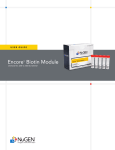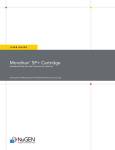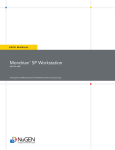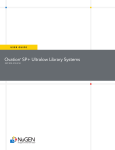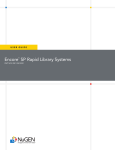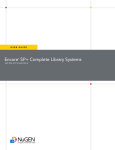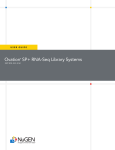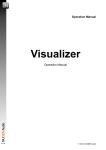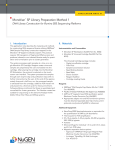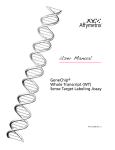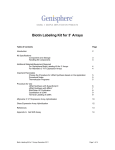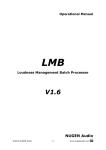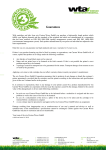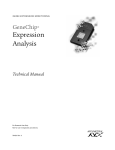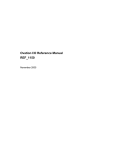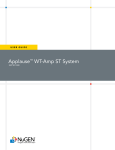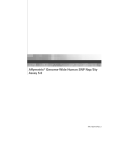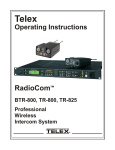Download Encore® Biotin Module
Transcript
USER GUIDE Encore Biotin Module ® Part NO. 4200 Patents, Licensing and Trademarks ©2009–2013 NuGEN Technologies, Inc. All rights reserved. The Encore®, Ovation® and Applause® families of products and methods of their use are covered by several issued U.S. and International patents and pending applications (www.nugeninc.com). NuGEN, Ovation, SPIA, Ribo-SPIA, Applause, Encore, Prelude, Mondrian and Imagine More From Less are trademarks or registered trademarks of NuGEN Technologies, Inc. Other marks appearing in these materials are marks of their respective owners. Specific information on patents, trademarks and licenses related to the Mondrian™ SP Universal Cartridge, the Mondrian™ SP+ Cartridge, the Mondrian™ SP Workstation and the Mondrian™ SP+ Workstation may be found in the Mondrian SP Universal Cartridge User Guide (M01265), the Mondrian SP+ Cartridge User Guide (M01344), the Mondrian SP Workstation User Manual (Part No. M01264) and the Mondrian SP+ Workstation User Manual (M01322). The purchase of this product conveys to the buyer the limited, non-exclusive, non-transferable right (without the right to modify, reverse engineer, resell, repackage or further sublicense) under these patent applications and any patents issuing from these patent applications to use this product and methods, accompanying this user guide, for research and development purposes solely in accordance with the intended use described and the written instructions provided in this user guide. No license to make or sell products by use of this product is granted to the buyer whether expressly, by implication, by estoppels or otherwise. In particular, the purchase of this product does not include or carry any right or license to use, develop or otherwise exploit this product commercially and no rights are conveyed to the buyer to use the product or components of the product for purposes including commercial services or clinical diagnostics. For information on purchasing a license to the NuGEN patents for uses other than in conjunction with this product or to use this product for purposes other than research, please contact NuGEN Technologies, Inc., 201 Industrial Road, Suite 310, San Carlos, CA 94070. Phone 888-654-6544 or 650-590-3600; FAX 888-296-6544 or 650-590-3630. Warranty NuGEN warrants that this product meets the performance standards described in the Company’s product and technical literature for a period of six months from the date of purchase, provided that the product is handled and stored according to published instructions, and that the product is not altered or misused. If the product fails to meet these performance standards, NuGEN will replace the product free of charge or issue a credit for the purchase price. NuGEN’s liability under this warranty shall not exceed the purchase price of the product. NuGEN shall assume no liability for direct, indirect, consequential or incidental damages arising from the use, results of use or inability to use its products. NuGEN reserves the right to change, alter or modify any product to enhance its performance and design. NuGEN’s products are developed, designed and sold FOR RESEARCH USE ONLY. This product is not to be used for diagnostic or therapeutic purposes, nor is it to be administered to humans or animals. Except as expressly set forth herein, no right to modify, reverse engineer, distribute, offer to sell or sell NuGEN’s product is conveyed or implied by buyer’s purchase of this NuGEN product. The buyer agrees to use NuGEN products accompanying the product insert in accordance with the intended use and the written instructions provided. Table of Contents Contents I.Introduction.......................................................................................................... 1 A.Background ....................................................................................................... 1 B. Fragmentation and Labeling Process ................................................................ 1 C. Performance Specifications................................................................................ 1 D. Quality Control .................................................................................................. 1 E. Storage and Stability.......................................................................................... 2 F. Material Safety Data Sheet (MSDS).................................................................... 2 II. Kit Components................................................................................................... 3 A. Reagents and Supplies Provided....................................................................... 3 B. Additional Equipment, Reagents and Labware................................................. 3 III. Planning the Experiment...................................................................................... 5 A. Input RNA Requirements................................................................................... 5 B. Using Nuclease-free Techniques........................................................................ 6 C. Amplified Input cDNA Storage.......................................................................... 6 D. Fragmented and Labeled cDNA Storage.......................................................... 6 IV.Protocol................................................................................................................ 7 A.Overview............................................................................................................ 7 B. Protocol Notes................................................................................................... 7 C. Preparing cDNA Samples.................................................................................. 8 D. Programming the Thermal Cycler...................................................................... 9 E. cDNA Fragmentation ........................................................................................ 9 F. Biotin Labeling ................................................................................................ 10 V. Technical Support............................................................................................... 12 VI.Appendix............................................................................................................ 13 A. Target Preparation for Affymetrix GeneChip® Eukaryotic Array Analysis................................................................................................... 13 B. Quality Control of Amplified, Fragmented and Labeled cDNA Product.................................................................................................. 15 C. Input cDNA Analysis: Measuring Concentration and Purity............................ 16 D. Frequently Asked Questions (FAQs)................................................................ 17 E. Update History ................................................................................................ 20 I.Introduction A. Background NuGEN’s proprietary fragmentation and labeling process (patent pending) combines enzymatic and chemical processes for the preparation of labeled cDNA to generate labeled targets suitable for hybridization to Affymetrix GeneChip® arrays. The Encore® Biotin Module is validated for use with amplified cDNA generated using the following NuGEN products: • Ovation® RNA Amplification System V2 (Part No. 3100) • Ovation Whole Blood Solution (Part Nos. 3100 and 1300) • Ovation Pico WTA Systems V1 and V2 (Part Nos. 3300, 3302) • Ovation PicoSL WTA Systems V1 and V2 (Part Nos. 3310, 3312) • WT-Ovation® FFPE System V2 (Part No. 3400) • Ovation FFPE WTA System (Part No. 3403) • WT-Ovation Exon Module (Part No. 2000) • WT-Ovation One-Direct System (Part No. 3500) • Applause® WT-Amp ST and WT-Amp Plus ST (Part Nos. 5500, 5510) • Applause 3’-Amp System (Part No. 5100) The labeled cDNA target generated with the Encore Biotin Module is suitable for hybridization to Affymetrix GeneChip® arrays. Please refer to the amplification system user guides and www.nugeninc.com for appropriate sample preparation and labeling system workflows for your application and desired array platform. B. Fragmentation and Labeling Process This novel and proprietary two-step fragmentation and labeling process is carried out by a simple “add and incubate” procedure and does not require purification steps. The first step is a combined chemical and enzymatic fragmentation process that yields cDNA products in the 50 to 100 base range. In the second step, this fragmented product is labeled via enzymatic attachment of a biotin-labeled nucleotide to the 3-hydroxyl end of the fragmented cDNA generated in the first step. C. Performance Specifications The fragmentation and biotin labeling process is performed in approximately two hours and produces labeled cDNA ranging from 50 to 100 bases ready for hybridization to GeneChip arrays. D. Quality Control Each Encore Biotin Module lot is tested to meet specifications for product size and array performance. 1 Encore Biotin Module I.Introduction E. Storage and Stability The Encore Biotin Module is shipped on dry ice and should be unpacked immediately upon receipt. All components should be stored at –20°C on internal shelves of a freezer without a defrost cycle. Note: While the Encore Biotin Module is shipped on dry ice, it is critical that it not be stored long term at -80°C as this may result in poor performance. This product has been tested to perform to specifications after as many as six freeze/ thaw cycles. Kits handled and stored according to the above guidelines will perform to specifications for at least six months. F. Material Safety Data Sheet (MSDS) An MSDS for this product is available on the NuGEN website at http://www.nugeninc.com/nugen/index.cfm/support/user-guides/. 2 Encore Biotin Module II. Kit Components A. Reagents and Supplies Provided Table 1. cDNA Fragmentation and Biotin Labeling Reagents COMPONENT 4200-12 PART NUMBER 4200-60 PART NUMBER 4200‑A01 PART NUMBER VIAL CAP VIAL NUMBER Fragmentation Buffer Mix S01182 S01182 S01177 Orange FL1 Fragmentation Enzyme Mix S01175 S01183 S01178 Orange FL2 Labeling Buffer Mix S01184 S01184 S01179 Orange FL3 Biotin Reagent S01172 S01185 S01180 Orange FL4 Labeling Enzyme Mix S01173 S01186 S01181 Orange FL5 B. Additional Equipment, Reagents and Labware Required Materials • Equipment -- Microcentrifuge for individual 1.5 mL and 0.5 mL tubes -- Microcentrifuge for 0.2 mL individual and 8 X 0.2 mL strip PCR tubes -- 0.5–10 µL pipette, 2–20 µL pipette, 20–200 µL pipette, 200–1000 µL pipette -- Vortexer -- Thermal cycler with 0.2 mL tube heat block, heated lid, and 100 µL reaction capacity -- Appropriate spectrophotometer and cuvettes, or Nanodrop® UV-Vis Spectrophotometer • Labware -- Nuclease-free pipette tips -- 1.5 mL and 0.5 mL RNase-free microcentrifuge tubes -- 0.2 mL individual thin wall PCR tubes or 8 X 0.2 mL strip PCR tubes -- Appropriate spectrophotometer cuvettes -- Disposable gloves -- Kimwipes -- Ice bucket 3 Encore Biotin Module II. Kit Components Optional Equipment • Agilent 2100 bioanalyzer or other equipment for electrophoretic analysis of RNA • Real-time PCR system 4 Encore Biotin Module III.Planning the Experiment A. Input RNA Requirements 1. cDNA Source The most important requirement for achieving successful results with the Encore Biotin Module is to use cDNA generated with one of NuGEN’s Ovation System or Applause System amplification products that have been validated for use with this module. Note: The Encore Biotin Module is designed solely for use with cDNA prepared using the NuGEN products listed below. It is not designed for use with cDNA from other sources. • • • • • • • • • • Ovation® RNA Amplification System V2 (Part No. 3100) Ovation Whole Blood Solution (Part Nos. 3100 and 1300) Ovation Pico WTA Systems V1 and V2 (Part Nos. 3300, 3302) Ovation PicoSL WTA Systems V1 and V2 (Part Nos. 3310, 3312)* WT-Ovation™ FFPE System V2 (Part No. 3400) Ovation FFPE WTA System (Part No. 3403) WT-Ovation Exon Module (Part No. 2000) WT-Ovation One-Direct System (Part No. 3500) Applause™ WT-Amp ST and WT-Amp Plus ST (Part Nos. 5500, 5510)** Applause 3’-Amp System (Part No. 5100)** *Note: With the Ovation PicoSL Systems V1 and V2, use half the recommended volumes throughout the Encore Biotin Labeling protocol. **Note: Fragmentation and Labeling protocols for cDNA generated using the Applause products are found in the respective user guides. The unlabeled cDNA product may be stored at –20°C, with minimum freeze/thaw cycles prior to labeling. For recommendations on input cDNA quality assessment, see Appendices B and C of this user guide. You may also choose to qualify the starting cDNA by performing qPCR assays as recommended in the appropriate NuGEN Amplification System user guides. 2. cDNA Purity The cDNA used with the Encore Biotin Module must be purified using a supported purification method as noted in the appropriate NuGEN amplification system product user guide. The adjusted 260/280 absorbance ratio of the purified SPIA cDNA should be >1.8. 5 Encore Biotin Module III.Planning the Experiment B. Using Nuclease-free Techniques Nuclease contamination from equipment and work environment will lead to experimental failure. Follow these guidelines to minimize contamination: • • • • Wear disposable gloves and change them frequently. Avoid touching surfaces or materials that could introduce DNases. Use only the reagents provided and recommended. Prior to initiating protocol, clean and decontaminate work areas and instruments, including pipettes, with commercially available decontamination reagents. • Use only new DNase-free pipette tips and microcentrifuge tubes. C. Amplified Input cDNA Storage The unlabeled cDNA product generated by NuGEN amplification system products may be stored at –20°C for up to six months prior labeling. D. Fragmented and Labeled cDNA Storage The labeled cDNA product produced by this kit can be used immediately after preparation, or stored at –20°C for up to 6 months prior to use in array hybridization. 6 Encore Biotin Module IV.Protocol A. Overview The cDNA labeling reaction is performed in two steps: 1.cDNA fragmentation 0.5 hours 2.Biotin attachment 1.25 hours Total time to label amplified cDNA 1.75 hours B. Protocol Notes • This protocol should be carried out in a post-amplification workspace designated for handling SPIA cDNA amplification products using dedicated postamplification equipment and consumables. Care should be exercised to avoid the introduction of SPIA cDNA into workspaces used to set up SPIA amplification reactions. For more information on this topic please refer to the NuGEN RNA amplification product user guide or contact NuGEN Technical Services. • Thaw only components used in each step and immediately place them on ice. • Always keep thawed reagents and reaction tubes on ice unless otherwise instructed. • After thawing and mixing buffer mixes, if any precipitate is observed, re-dissolve it completely prior to use. You may gently warm the buffer mix for two minutes at room temperature followed by brief vortexing. Do not warm any enzyme mixes. • FL3 labeling buffer may appear to have pink coloration. This is normal. • Spin down labeling master mix briefly at low speed. High speed spins for long periods can cause formation of a precipitate. • The reagent volumes recovered greatly depend on the number of batches processed with each kit. Set up no fewer than three reactions at a time with the 4200-12 kit, no fewer than 10 reactions at a time with 4200-60, and no fewer than 48 reactions at a time with 4200-A01. The 4200-A01 kit has been designed for use with automation protocols requiring large batch sizes. For information on automation solutions contact NuGEN Technical Services. • When placing small amounts of reagents into reaction mix, gently pipet up and down several times to ensure complete transfer. • When instructed to pipet mix, gently aspirate and dispense at least half of total reaction mix volume. Repeat a minimum of five times to ensure complete mixing. • Allow the thermal cycler to reach incubation temperature before placing samples in the block. • When working with more than one sample, excess master mix may be needed. • Components of this NuGEN product should not be used or combined with any other Ovation Systems or Applause products and vice versa. 7 Encore Biotin Module IV.Protocol C. Preparing cDNA Samples The amount of amplified cDNA required for each fragmentation and labeling reaction depends on the method of cDNA generation. Specific NuGEN sample preparation systems have been validated for use with the Encore Biotin Module and the required cDNA input from each are listed in Table 2. Ensure that the correct input is used in section IV.E., step 6 of the Fragmentation protocol. Table 2. cDNA Input Requirements for Fragmentation and Labeling Reactions and Final Hybridization Cocktail Concentrations cDNA INPUT PER REACTION* FINAL HYB COCKTAIL CONCENTRATION WT-Ovation One-Direct RNA Amplification System (Cat. #3500) 5–6 µg 23-27 ng/µL Ovation FFPE WTA System (Part No. 3403) 4–5 µg 18-23 ng/µL WT-Ovation FFPE System V2 (Part No. 3400) 4–5 µg 18-23 ng/µL 5 µg 23 ng/µL Ovation PicoSL WTA Systems V1 and V2 (Part No. 3310/3312) 2.5 µg** 23 ng/μL Ovation RNA Amplification System V2 (Part No. 3100) 3.75 µg 17 ng/µL Ovation Whole Blood Solution (Part No. 1300 & 3100) 4.4 µg 20 ng/µL 5 µg 23 ng/µL Applause WT-Amp ST and WT-Amp Plus ST (Part No. 5500/5510) Refer to the appropriate Applause user guide Refer to the appropriate Applause user guide Applause 3’-Amp System (Part No. 5100) Refer to the appropriate Applause user guide Refer to the appropriate Applause user guide NUGEN AMPLIFICATION SYSTEM (Part No. ) Ovation Pico WTA Systems V1 and V2 (Part No. 3300/3302) WT-Ovation Exon Module (Part No. 2000) * All cDNA concentrations are assessed using 33 µg/mL/A260 as the constant. ** Requires performing half-volume Encore Biotin Module reactions. Refer to the appropriate Ovation PicoSL WTA System user guide for specific guidelines. 8 Encore Biotin Module IV.Protocol D. Programming the Thermal Cycler Use a thermal cycler with a heat block designed for 0.2 mL tubes, equipped with a heated lid, and with a capacity of 100 µL reaction volume. Prepare the programs shown in Table 3, following the operating instructions provided by the manufacturer. For thermal cyclers with an adjustable heated lid, set the lid temperature at 100°C. For thermal cyclers with a fixed temperature heated lid (e.g., ABI GeneAmp® PCR 9600 and 9700 models) use the default settings (typically 100 to 105°C). Table 3. Thermal Cycler Programming PROGRAMMING DETAILS Program 1 cDNA Fragmentation 37°C – 30 min, 95°C – 2 min, hold at 4°C Program 2 Biotin Labeling 37°C – 60 min, 70°C – 10 min, hold at 4°C E. cDNA Fragmentation 1. Obtain the Fragmentation Buffer Mix (Orange: FL1) and Fragmentation Enzyme Mix (Orange: FL2) from -20°C storage. Note: You may thaw all reagents at once. Refer to the Labeling protocol for thawing and mixing instructions for the Labeling reagents. 2. Thaw FL1 at room temperature, mix by vortexing, spin and place on ice. 3. Mix FL2 by inverting the tube 3 times, spin and place on ice. 4. Add 25 µL of the purified SPIA cDNA into a PCR tube on ice. Refer to Table 2 to determine the amount of required amplified cDNA input. Add water, if necessary, to bring up the volume of the cDNA sample to 25 µL. 5. Make the Fragmentation Master Mix by combining FL1 and FL2 in a 0.5 mL capped tube, according to the volumes shown in Table 4. Table 4. Fragmentation Master Mix (volumes listed are for a single reaction) Use Fragmentation Master Mix immediately after preparation. FRAGMENTATION BUFFER MIX (ORANGE: FL1) FRAGMENTATION ENZYME MIX (ORANGE: FL2) 5 µL 2 µL 6. Mix by pipetting, spin and place on ice. Use the master mix immediately. 9 Encore Biotin Module IV.Protocol 7. Add 7 µL of the Fragmentation Master Mix to each sample. 8. Mix well by pipetting 8 to 10 times. 9. Vortex briefly to ensure thorough mixing, spin and place on ice. 10. Place the tubes in a pre-warmed thermal cycler programmed to run Program 1 (cDNA Fragmentation, see Table 3): 37°C – 30 min, 95°C – 2 min, hold at 4°C 11. Remove the tubes from the thermal cycler, spin to collect condensation and place on ice. Continue immediately with the Biotin Labeling protocol. F. Biotin Labeling 1. Obtain the Labeling Buffer Mix (Orange: FL3), Biotin Reagent (Orange: FL4) and the Labeling Enzyme Mix (Orange: FL5) from the product box stored at –20°C. 2. Place all reagents on ice. 3. Thaw FL3 and FL4 at room temperature, mix by vortexing, spin and place on ice. 4. Mix FL5 by inverting the tube 3 times, spin and place on ice. 5. Make a Labeling Master Mix as outlined below: Table 5. Labeling Master Mix (volumes listed are for a single reaction) Use Labeling Master Mix immediately after preparation. LABELING BUFFER MIX (ORANGE: FL3) BIOTIN REAGENT (ORANGE: FL4) LABELING ENZYME MIX (ORANGE: FL5) 15 µL 1.5 µL 1.5 µL 6. Mix by pipetting, spin and place on ice. Use the master mix immediately. 7. Add 18 µL of the Labeling Master Mix to each fragmented cDNA sample tube. 8. Mix well by pipetting 8 to 10 times. 9. Vortex briefly to ensure thorough mixing, spin and place on ice. 10. Place tubes in a pre-warmed thermal cycler programmed to run Program 2 (Biotin Labeling, see Table 3): 37°C – 60 min, 70°C – 10 min, hold at 4°C 10 Encore Biotin Module IV.Protocol 11. After completion, remove tubes from thermal cycler, spin to collect condensation and place on ice. 12. The fragmented and labeled cDNA may be processed immediately for array hybridization or stored at –20°C. For recommendations on array hybridization, see Appendix A. 11 Encore Biotin Module V. Technical Support For Technical Support, please contact NuGEN at (U.S. only) 888.654.6544 (Toll-Free Phone) or 888.296.6544 (Toll-Free Fax) or email [email protected]. In Europe contact NuGEN at +31(0)135780215 (Phone) or +31(0)135780216(Fax) or email at [email protected]. In all other locations, contact your NuGEN distributors Technical Support team. 12 Encore Biotin Module VI.Appendix A. Target Preparation for Affymetrix GeneChip® Eukaryotic Array Analysis In general, cDNA targets labeled using the Encore Biotin Module are prepared for analysis on Affymetrix GeneChip arrays according to the manufacturer’s guidlines. Some specific exceptions are noted below. Using the Affymetrix Hybridization Wash and Stain Kit with GeneChip 3’ Expression Arrays or Whole Transcript Arrays Guidelines for processing GeneChip Whole Transcript Arrays (e.g., Gene ST and Exon ST arrays) can be found in the Affymetrix GeneChip Whole Transcript (WT) Sense Labeling Assay User Manual (Affymetrix Part No. 701880 Rev. 5) unless otherwise noted below. Guidelines for processing GeneChip 3’ Expression Arrays (e.g., HG-U133 arrays) can be found in the Affymetrix GeneChip Expression Analysis Technical Manual (Affymetrix Part No. 702232 Rev. 3) unless otherwise noted below. • Refer to Table 6 for guidelines on hybridization cocktail formulation and hybridization cocktail loading volume with NuGEN prepared samples. • Heat denature the hybridization cocktail at 99°C for 2 minutes (not 5 minutes as specified by Affymetrix), then follow the Affymetrix protocol (45°C in a heat block for 5 minutes then centrifuge at maximum speed for 1 minute just prior to loading). • We recommend a hybridization time of 18 hours ± 2 hours. Hybridization for 16 to 20 hours yields comparable results. • Refer to Table 6 for guidelines on selection of the appropriate fluidics scripts. Note that in some cases the optimal fluidics script will be different for NuGEN targets than for Affymetrix labeled targets. Using Target Prepared With the WT-Ovation One-Direct System: We recommend extending the array hybridization time to 40 hours when using the WT-Ovation One-Direct System to maximize detection sensitivity with the exceedingly small samples used. 13 Encore Biotin Module VI.Appendix Table 6. Hybridization, Cocktail Assembly and Fluidics Protocols for Single GeneChip® Arrays using Affymetrix HWS kit (Affymetrix P/N 900720) COMPONENT STANDARD ARRAY (49 or 64 FORMAT) MIDI ARRAY (100 FORMAT) MINI ARRAY (169 FORMAT) FINAL CONCENTRATION Fragmented, biotin-labeled amplified cDNA 50 µL 34 µL 25 µL Depends on sample type and amplification method* Control oligonucleotide B2 (3 nM) 3.7 µL 2.5 µL 1.9 µL 50 pM 20X Eukaryotic hybridization controls (bioB, bioC, bioD, cre) 11 µL 7.5 µL 5.5 µL 1.5, 5, 25 and 100 pM, respectively 2X Hybridization buffer 110 µL 75 µL 55 µL 1X 100% DMSO 22 µL 15 µL 11 µL 10% Water 23.3 µL 16 µL 11.6 µL N/A Total Volume 220 µL 150 µL 110 µL Array Loading Volume 200 µL 130 µL 90 µL FLUIDICS PROTOCOLS For 3’ arrays FS450_0004 For ST arrays FS450_0001 (Exon arrays) FS450_0002 FS450_0007 (Gene arrays) *Refer to Table 2 for cDNA input requirements into fragmentation and labeling reactions and final hybridization cocktail concentrations. 14 Encore Biotin Module VI.Appendix B. Quality Control of Amplified, Fragmented and Labeled cDNA Product The size distribution of the final fragmented and biotinylated product may be viewed on an Agilent Bioanalyzer by loading 100 ng of each sample before and after the fragmentation and labeling process on an RNA 6000 Nano LabChip® (Agilent Part No. 5065-4476) using the Total RNA program following the manufacturer’s instructions. Product that is not sufficiently fragmented has been shown to yield poor results on GeneChip arrays. For good results on GeneChip arrays, 80% or greater of the fragmented cDNA product should be smaller than 200 bases in length. For examples of Bioanalyzer traces of unfragmented and fragmented cDNA product, refer to Figure 1. Figure 1. Bioanalyzer Trace of Amplified, Un-fragmented and Fragmented cDNA Product. HeLa RNA amplified with the Ovation Pico WTA System (Part No. 3300) was processed with the Encore Biotin Module, and analyzed on an Agilent Bioanalyzer. Unfragmented cDNA traces will vary depending on amplification method and sample type. 12.5 RNA 6000 Ladder SPIA cDNA Fluorescence 10.0 Fragmented and Labeled cDNA 7.5 5.0 2.5 0.0 19 15 Encore Biotin Module 24 29 34 39 44 49 Time (seconds) 54 59 64 69 VI.Appendix C. Input cDNA Analysis: Measuring Concentration and Purity 1. Before using the Encore Biotin Module, it is highly recommended to determine the concentration of your sample to ensure sufficient cDNA input for the labeling process. 2. Mix the sample by brief vortexing and spinning prior to checking the concentration. 3. Measure the absorbance of the amplified cDNA product at 260, 280 and 320 nm. You may need to make a 1:20 dilution of the cDNA in water prior to measuring the absorbance. 4. Purity: Subtract the A320 value from both A260 and A280 values. The adjusted (A260 – A320 / A280 – A320) ratio should be >1.8. 5. Yield: Assume 1 A260 unit = 33 µg/mL. To calculate: (A260 – A320 of diluted sample) X (dilution factor) X 33 (concentration in µg/mL/A260 unit) X 0.03 (final volume in mL) = total yield in micrograms 6. Alternatively you may measure the concentration and purity of cDNA with a Nanodrop, using 33 µg/mL/A260 unit as the constant. 16 Encore Biotin Module VI.Appendix D. Frequently Asked Questions (FAQs) Q1. What materials are provided with the Encore Biotin Module? The Encore Biotin Module provides all necessary buffers and enzymes for fragmentation and labeling of cDNA generated with a validated NuGEN Amplification System. Q2. What equipment is required or will be useful? You will need a microcentrifuge, pipettes, vortexer, a thermal cycler and a UV-Vis spectrophotometer. An Agilent Bioanalyzer or a similar instrument may be used for quality control. Q3. What additional reagents are required for the Encore Biotin Module? No additional reagents are required. Q4. What type of cDNA should I use with the Encore Biotin Module? You must use SPIA cDNA generated with one of the following NuGEN products with the Encore Biotin Module : • Ovation RNA Amplification System V2 (Part No. 3100) • Ovation Whole Blood Solution (Part Nos. 3100 and 1300) • Ovation Pico WTA Systems V1 and V2 (Part No. 3300/3302) • Ovation PicoSL WTA Systems V1 and V2 (Part No. 3310/3312) • Ovation FFPE WTA System (Part No. 3403) • WT-Ovation FFPE System V2 (Part No. 3400) • WT-Ovation Exon Module (Part No. 2000) • WT-Ovation One-Direct System (Part No. 3500) • Applause WT-Amp ST and WT-Amp Plus ST (Part No. 5500/5510) • Applause 3’-Amp System (Part No. 5100) Q5. How much labeled cDNA should I hybridize to a GeneChip array? Refer to Appendix A for guidance regarding the use of the Encore Biotin Module with Affymetrix GeneChip Arrays. Q6. Can I vary the amount of cDNA input to fragmentation and labeling? You may use from 2 to 6 µg of cDNA input with the Encore Biotin Module. Refer to Table 2 to determine the specific recommendations for your sample type, array type and amplification kit used. We recommend using the same cDNA input across all samples in a single experiment where a range of inputs is given. Q7. Can I use any cDNA as starting material in the Encore Biotin Module? No, the cDNA must be generated using a validated NuGEN amplification system. Use of other cDNAs will result in poor performance. Q8. How much fragmented and labeled cDNA yield can I expect? Since this module does not require any purification, the final yield is equal to the amount of cDNA input. 17 Encore Biotin Module VI.Appendix Q9. What is the size range of fragmented cDNA generated by the Encore Biotin Module? As measured with an Agilent Bioanalyzer, 80% of product falls below 200 bases with an average peak at 85 bases. Q10.Has NuGEN performed reproducibility studies on the Encore Biotin Module? Yes, our studies have included sample-to-sample, lot-to-lot and operator-tooperator reproducibility. Refer to the Encore Biotin Module Technical Report #1 for a summary of our performance data. Q11.Can the Encore Biotin Module be used for fragmentation and labeling of RNA? No. Q12.Should I purify the labeled cDNA before hybridization? No. Purification of the labeled cDNA is not necessary. Q13.What are the recommended storage conditions for the labeled cDNA? The labeled cDNA is to be stored at –20°C. Ensure the vials are well sealed and avoid multiple freeze/thaw cycles. Q14.What types of arrays work with the Encore Biotin Module cDNA? The Encore Biotin Module has been validated on Affymetrix 3’ Expression and GeneChip Whole Transcript Arrays (such as Gene ST or Exon ST arrays). Q15.Are the array hybridization reagents included in the Encore Biotin Module? No. Refer to Appendix A for information on array hybridization protocols. Q16.What hybridization and wash protocols do you recommend for Affymetrix GeneChip applications? Refer to Appendix A for information on array hybridization protocols. Q17.Where can I safely stop in the Encore Biotin Module protocol? We do not recommend stopping at any step of the protocol. Q18.How do I determine fragmentation success? You may use an Agilent Bioanalyzer to inspect the size distribution of samples before and after fragmentation as described in Appendix B. Q19.How should I qualify my cDNA for use with the Encore Biotin Module? You must use cDNA generated with a validated NuGEN amplification system. The concentration of starting cDNA must be determined to ensure adequate input into the labeling reaction and, therefore, onto the arrays. Please refer to Table 2 for cDNA input requirements. You may choose to further qualify the input cDNA by performing qPCR assays as recommended in the appropriate NuGEN amplification system user guides. 18 Encore Biotin Module VI.Appendix Q20.Which protocol should I use for cDNA produced using Applause 3’-Amp, Applause WT-Amp ST and WT-Amp Plus ST RNA Amplification Systems? The protocols for labeling cDNA amplified with Applause 3’-Amp, Applause WT-Amp ST and WT-Amp Plus ST are found in the respective user guides for these products. 19 Encore Biotin Module VI.Appendix E. Update History This document, the Encore Biotin Module user guide (M01111 v6), is an update to address the following topics. Description Corrected component name of FL4 to ‘Biotin Reagent’ Section Page(s) IV.F. 10 NuGEN Technologies, Inc. Headquarters USA Europe 201 Industrial Road, Suite 310 San Carlos, CA 94070 USA Toll Free Tel: 888.654.6544 Toll Free Fax: 888.296.6544 [email protected] [email protected] P.O. Box 109 9350 AC Leek The Netherlands Tel: +31-13-5780215 Fax: +31-13-5780216 [email protected] For our international distributors contact information, visit our website www.nugeninc.com ©2009–2013 NuGEN Technologies, Inc. All rights reserved. The Encore®, Ovation® and Applause® families of products and methods of their use are covered by several issued U.S. and International patents and pending applications (www.nugeninc.com). NuGEN, Ovation, SPIA, RiboSPIA, Applause, Encore, Prelude, Mondrian and Imagine More From Less are trademarks or registered trademarks of NuGEN Technologies, Inc. Other marks appearing in these materials are marks of their respective owners. M01111 v6 For research use only.

























